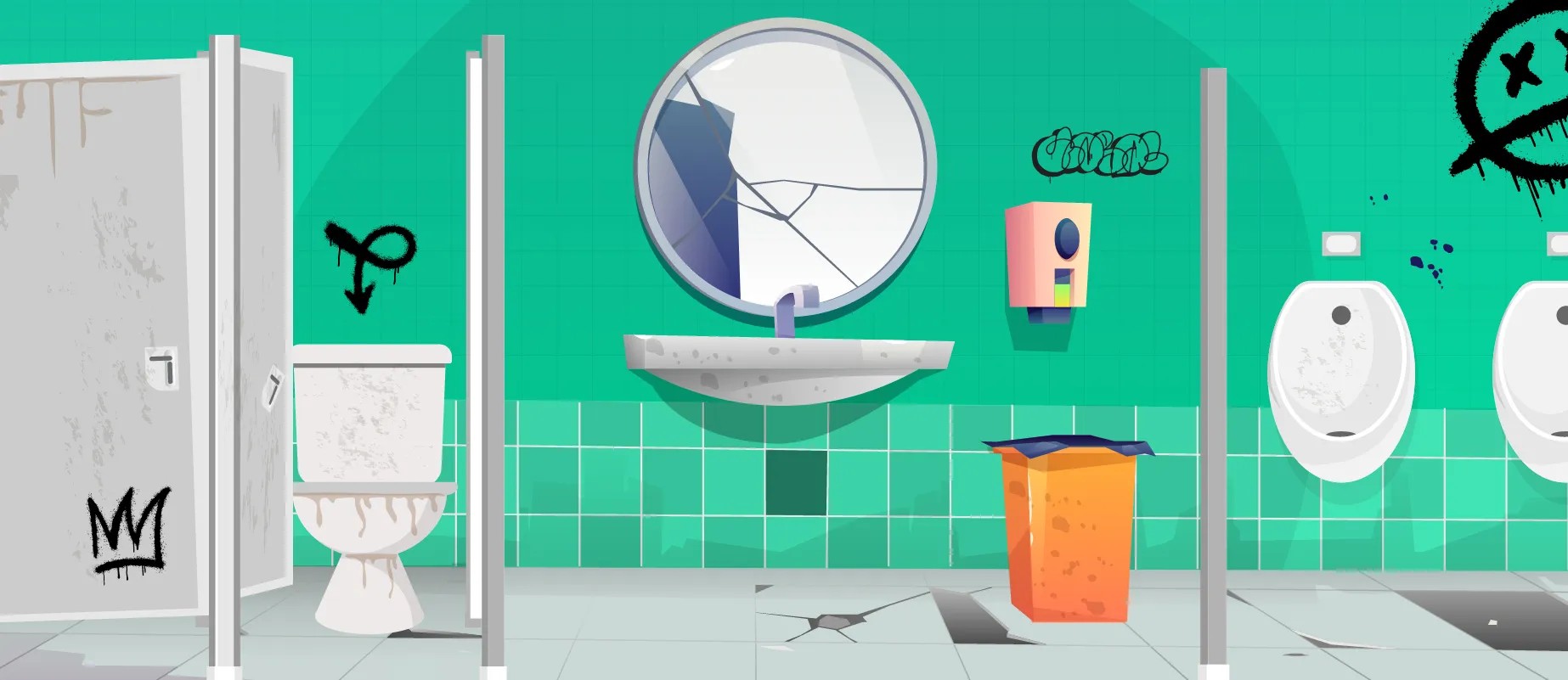In the News: Enhancing Safety in Schools Across Minnesota
Read the Story
SmartPass Co-Founders Listed on Forbes 30 Under 30
Read the Story

Lee Moskowitz
.avif)

We've all seen it. A few of us have even done it. Bathroom vandalism has always been an issue for schools. But today, educators are dealing with these problems like never before. Bathroom vandalism has become highly destructive and costly.
In fact, the yearly cost of school vandalism in general is estimated at $1 billion nationwide. Shockingly, a significant portion of this damage occurs in the bathrooms. Why? It's one of the few places students aren’t monitored. This unchecked environment has unfortunately turned restrooms into prime targets for vandalism, impacting not only the school's financial resources but also its overall safety and environment.
However, amidst these challenges lies an opportunity for proactive measures to prevent vandalism and promote a safer school environment. By implementing innovative solutions and fostering a culture of accountability, schools can effectively combat bathroom vandalism and reclaim their restrooms as spaces of cleanliness, safety, and respect.
Bathroom vandalism in schools goes beyond the surface damage to facilities; it has far-reaching consequences that impact student safety, school finances, and accountability measures.
School vandalism, in general, poses a significant threat to student safety and security within school environments. Damaged or defaced facilities not only create physical hazards but also contribute to a sense of insecurity and unease among students. Vandalism can also undermine the effectiveness of security measures put in place to protect students. Tampering with surveillance cameras, blocking emergency exits, or damaging security equipment can weaken the school's ability to respond to emergencies and maintain order on campus. By compromising security protocols, vandalism jeopardizes the safety and well-being of everyone within the school community.
If you’ve called a plumber recently, you can understand the significant burden bathroom vandalism can cause. Schools are forced to allocate precious resources to repair damages, diverting funds away from educational programs and student services. These funds could otherwise be invested in enhancing learning experiences and improving school facilities for the benefit of all students.
Bathroom vandalism also raises concerns about accountability within the school community. When acts of vandalism go unpunished or unaddressed, it sends a message that destructive behavior will not be met with consequences. This lack of accountability can erode the sense of respect and responsibility among students, undermining efforts to foster a positive school culture. Schools can reinforce the importance of respect for property and community well-being by holding individuals accountable for their actions and implementing deterrent measures.
The effects of bathroom vandalism extend beyond the physical damage to facilities. To mitigate these effects, proactive measures must be taken to prevent vandalism, promote accountability, and uphold a safe and supportive learning environment for all.
Vandalism in school bathrooms is often grounded in underlying psychological factors and social dynamics that drive students to engage in destructive behaviors. Educators and administrators can gain insight into effective prevention strategies by examining these motives.
For many students, vandalism may serve as a release for pent-up emotions or frustrations. Those struggling with emotional regulation may resort to destructive acts as a means of coping with internal struggles. Providing support and resources to help students develop healthier coping mechanisms is essential in addressing this aspect of vandalism at its core.
Moreover, feelings of alienation or powerlessness can contribute to vandalism. Students who feel disconnected from their school community or marginalized may seek attention or control through destructive behavior. Fostering an inclusive and supportive school environment can mitigate these feelings and reduce the likelihood of vandalism.
Peer pressure is a significant influencer in vandalism incidents. Students may succumb to the pressure to conform to destructive behaviors in order to fit in or gain acceptance within their social circles. The convergence of vandalism with other societal issues, such as vaping and drug use, highlights the complex nature of the problem. Vaping incidents often draw students into bathrooms, creating opportunities for vandalism to occur. Educators must promote a culture of empathy and cooperation to counteract this influence, empowering students to make responsible choices.
The prevalence of social media exacerbates the impact of peer pressure. TikTok challenges have been linked to a rise in vandalism incidents, as acts of destruction garner online attention and validation. Trends like the "Devious Lick" challenge on TikTok can quickly spread destructive behaviors among students, including vandalism in school bathrooms.
Understanding the motives behind bathroom vandalism requires a nuanced approach that addresses psychological and social influences. Educators can effectively prevent and mitigate vandalism incidents in school bathrooms by promoting a positive school culture, supporting emotional well-being, and staying vigilant against emerging trends.
Preventing bathroom vandalism requires a multifaceted approach that addresses both the underlying motivations behind such acts and the practical measures to deter them. Here are actionable strategies and tips for schools to consider in their efforts.
Effective monitoring and securing of school bathrooms are crucial to maintaining a safe and conducive learning environment for students. Enhancing supervision in and around school bathrooms can serve as a deterrent to vandalism. Assigning staff members to monitor restroom areas during peak times, such as between classes or during lunch breaks, can help deter students from engaging in destructive behaviors. Conducting regular patrols of restroom facilities can help promptly identify and address vandalism incidents.
1. Surveillance Systems: Installing surveillance cameras near the entrances of school bathrooms can deter vandalism and unauthorized activities. These cameras can capture real-time footage of restroom areas, allowing school administrators to monitor for suspicious behavior and respond promptly to incidents. Additionally, signage indicating the presence of surveillance cameras can further deter potential vandals.
2. Access Control Measures: Implementing access control measures, such as keycards or biometric systems, can help restrict entry to school bathrooms to authorized individuals only. By limiting access to these facilities, schools can reduce the likelihood of vandalism and ensure that restrooms remain clean and secure. Access control systems can also track entry and exit times, providing valuable data for monitoring restroom usage patterns.
Effective monitoring and securing of school bathrooms are essential to deter vandalism, and promote responsible behavior, ultimately creating a safer and more conducive environment for all students.
Empowering students to take ownership of their school environment can significantly impact vandalism prevention efforts. Schools can establish student-led initiatives, such as peer monitoring programs or vandalism prevention committees, to promote accountability and foster a sense of pride in maintaining school facilities. Engaging students in developing and implementing bathroom vandalism prevention strategies can also increase their investment in creating a positive school climate. Here are some effective strategies for engaging students in vandalism prevention:
Encouraging students to take the lead in developing and implementing vandalism prevention initiatives can be highly effective. Student-led committees or clubs that promote respect for school property and foster a sense of community pride can empower students to take ownership of their school environment. These initiatives may include organizing awareness campaigns, creating artwork to beautify restroom facilities, such as murals or prints that reflect the school's values and culture, or implementing peer monitoring programs.
Harnessing the power of peer influence is another effective strategy for preventing bathroom vandalism. Peers can exert significant positive influence over each other's behavior just as much as negative influence, making peer-led interventions particularly impactful. Schools can leverage peer influence by promoting positive social norms and highlighting the importance of respecting school property. Encouraging students to hold each other accountable for their actions and intervene when they observe vandalism can help create a culture of mutual respect and responsibility.
Engaging students in vandalism prevention empowers them to take an active role in shaping their school environment and fosters a sense of ownership and belonging. Student-led initiatives provide opportunities for leadership development, collaboration, and civic engagement, helping students develop valuable skills and attributes that extend beyond the classroom. Moreover, involving students in prevention efforts promotes a sense of collective responsibility for maintaining a positive school climate, and fostering a culture of mutual respect and support among peers.
Raising awareness about the consequences of bathroom vandalism among students is essential in fostering a culture of respect and responsibility. Schools can implement educational campaigns that highlight the negative impacts of vandalism on the school community and emphasize the importance of maintaining clean and safe facilities. Utilizing custom posters, presentations, and workshops to disseminate information can effectively reach students and reinforce positive behavior.
Highlighting the consequences of vandalism is essential for reinforcing the importance of preventing such behaviors. Schools can educate students about the negative impacts of vandalism on the school community, including the financial costs of repairs, the compromised safety and security of facilities, and the erosion of trust and respect among peers. Emphasizing the potential disciplinary consequences of engaging in vandalism, such as suspension, restitution, or legal action, can serve as a deterrent and reinforce the expectation of responsible behavior.
Engaging students in preventing bathroom vandalism is a proactive approach that promotes a sense of ownership, responsibility, and accountability within the school community. By empowering students to take an active role in promoting positive behaviors, leveraging peer influence, and highlighting the consequences of vandalism, schools can create a culture of respect and stewardship that enhances all students' overall safety and well-being.
Integrating technology solutions like SmartPass can further enhance vandalism prevention efforts in schools. By monitoring and limiting hall pass usage, SmartPass helps schools monitor student movement and identify potential areas of concern, such as unauthorized gatherings in restrooms. By leveraging technology to deter unwanted behaviors and promote accountability, SmartPass offers a proactive approach to maintaining a safe and secure school environment.
Ensuring the safety and security of students within school premises is paramount to their overall well-being and academic success. Central to this effort is maintaining safe and clean school facilities, free from the disruptions caused by vandalism. SmartPass serves as a crucial tool in preventing bathroom meetups and addressing other safety concerns. With SmartPass, schools have real-time visibility into student movements, allowing them to track who is out, when, how often, and where they are going. Moreover, SmartPass enables schools to limit the number of students allowed in one bathroom at a time, helping to prevent overcrowding and unauthorized gatherings.
Safe and clean school facilities provide students with a conducive learning and personal growth environment. Students who feel secure in their surroundings can better focus on their studies and positively interact with peers and teachers. Additionally, well-maintained facilities contribute to a sense of pride and ownership among students, fostering a positive school culture.
Preventing bathroom vandalism requires a combination of proactive measures, student engagement, and innovative solutions. By implementing these strategies in tandem, schools can effectively deter vandalism and promote a culture of respect and responsibility among students.
Emphasizing a comprehensive approach that includes proactive measures, awareness, and student involvement is key to preventing vandalism and promoting student safety. By empowering students to take an active role in shaping their school environment and fostering a culture of respect and responsibility, schools can create a community where vandalism is deterred, and positive behaviors are encouraged.


.jpg)
